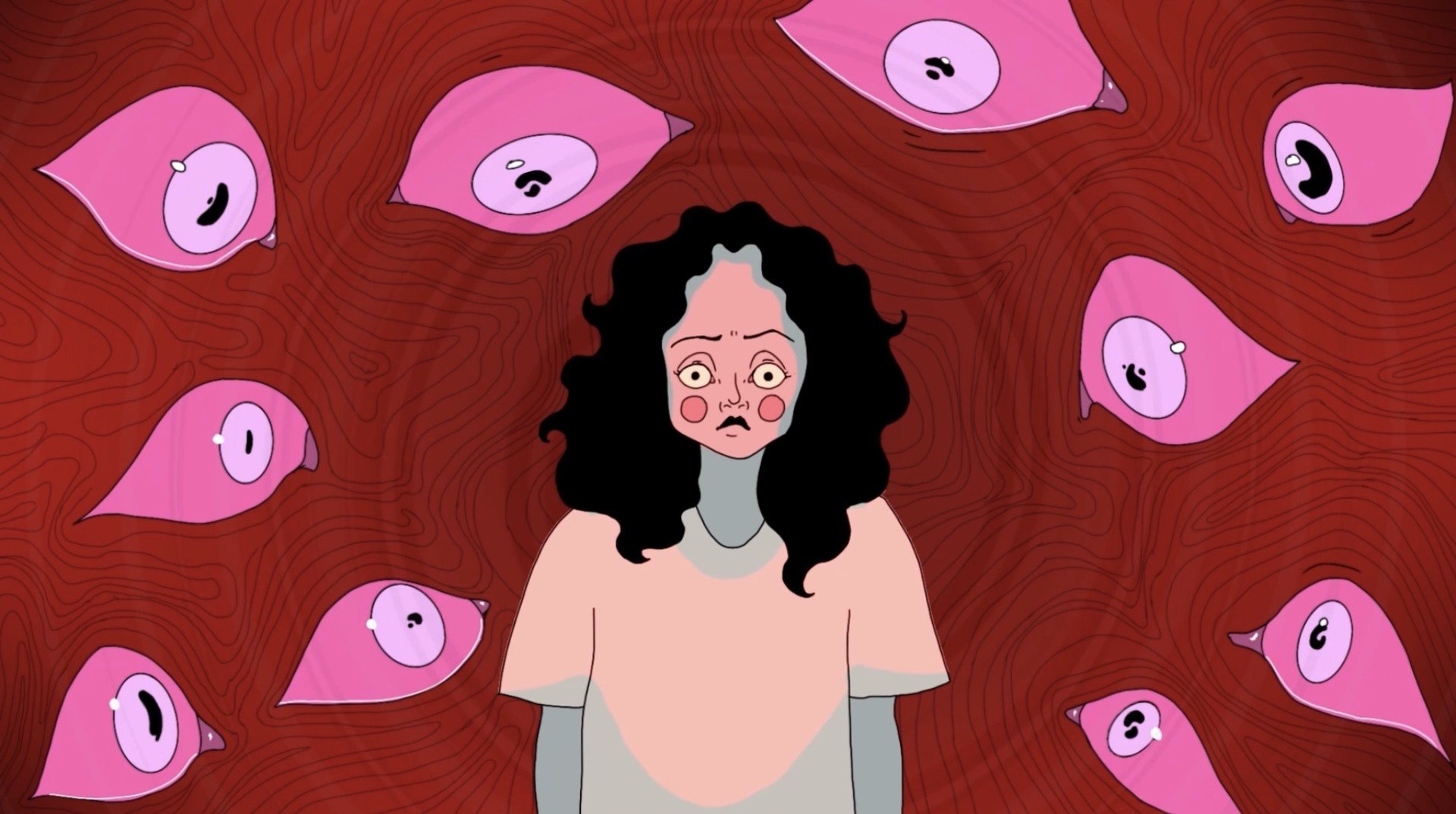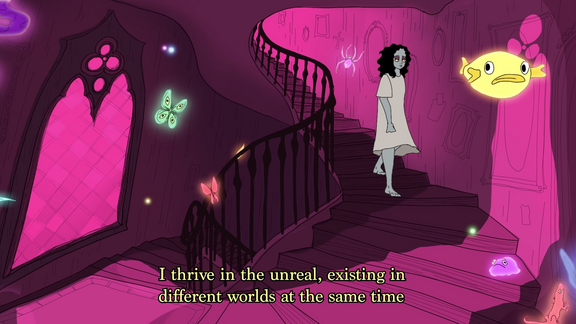JUNGLE
Directed by LEONOR CALAÇA
United Kingdom, 2022
Drama, Experimental
A girl wakes up to a morning existential crisis.
Read our interview with Leonor below to learn more about the film.
LEONOR CALAÇA
Est. Reading Time: 5 Minutes
MARK (M) I really like the way you use the jungle to capture and reflect an overwhelmed artist and mind - it’s very authentic and unique! We see lots of animals on screen such as butterflies, frogs, snails, spiders and even sea monsters.
Please tell us about your process of designing the film’s wildlife - did you have certain creatures in mind when you were conceptualizing the film? How many groups and types of animals did you end up considering before narrowing down your choices to the creatures that we see on screen?
LEONOR (L) I chose the animals based on the attributes humans usually associate them with. For example, I never considered mammals for the film’s wildlife because I thought they might feel friendlier and less uncanny. Bugs, lizards and fish are usually seen more distantly from humans and can be more triggering for the audience. My aim was to create a deep and vivid atmosphere but at the same time intense and disturbing enough to depict the girl’s chaotic existential crisis. I tried to include as many ‘unwanted’ or unpleasant animals as possible.
M And most importantly, how do these creatures reflect different aspects of the main character’s psyche and interior world?
L The animals represent the girl’s thoughts so they begin to appear as harmless little fish, bugs and amphibians. The darker the thoughts, the more threatening the animals become. The moment the girl says that she doesn’t want to exist, the predators slowly take over and start eating other animals which mean that her negative psyche is killing everything conceived within her mind. On the wall next to her bed, there is a weird bug with eyes on its wings. It is on the wall from the beginning, even before the girl has woken up. I thought of the bug as her consciousness since it watches everything happening without moving or being eaten.
On Narration
M I was moved by your narration, particularly the line ‘how many nows have I lost in this jungle?’ Please tell us about the importance of this line in understanding the main character’s angst and inner life. And please tell us about your process of crafting the film’s narration - did it change and grow over time?
L The line is inspired by the feeling one gets after coming out of a mentally dark place and realizing they lost the present moment. The bedroom clock stops and later catches up with the present moment because it can no longer hold time. For the girl, it means all those sped up minutes have been lost to her morning crisis. Being in a bad place mentally feels like time slows down but at the same time it feels like you can’t grasp the present. It feels like the present is lost in the ‘jungle’ of our thoughts.
L The film’s narration was originally longer but as I wouldn’t have been able to visually mirror every word spoken within the film’s runtime, it was narrowed down. The most impactful sentences were chosen and portrayed on screen. They are all based on personal thoughts and emotions I have when experiencing an existential crisis.
On Mental Health
M Your film portrays really important issues about the mental health crisis of young artists. How do you try to cope with constantly feeling frozen and overwhelmed as a young artist - what steps do you take to ensure it doesn’t stifle you too much?
L As an artist, I feel like what impacts me the most are my own internal paradoxes and my ability to feel everything very deeply. It is helpful for creativity but also highly inducing of an existential crisis like the one explored in this film. Even though it feels like the girl is a part of the jungle and has no way out of it, she really is just the observer. I like to remind myself that I am not my thoughts even if they are scary or painful, I don’t have to chase or react to them.
‘My aim was to create a deep and vivid atmosphere but at the same time intense and disturbing enough to depict the girl’s chaotic existential crisis’
— Leonor Calaça
On Process & Discovery
M In making and finishing the film, what did you discover and learn that you might adopt or further explore in future projects?
L I think my overall animation skills have developed with the making of this film. I also learnt more about compositing effects and tools in Adobe After Effects. Some of the film’s animation is digitally manipulated through the software’s special effects. I intend to further use these techniques in future projects. The making of this film also made me want to research more traditional illustration styles as I feel like more stylised/textured techniques would be interesting to explore in animation.
On Inspiration
M What are some of the films and who are some of the filmmakers that inspire you, and why?
L For this film, some of my inspirations were animation series like Love, Death & Robots (2019-) and short films like Vincent (1982). In Vincent, the main character’s inner/paracosm life is explored and there’s transitions between the normal and dark/imagined world. Even though I watched that short film a long time ago, I think it certainly influenced my take on the concept.
Vincent (1982) by Tim Burton
On The Future
M What are you planing to make next?
L I am currently working on my graduation film. The base of the story is inspired by my childhood memories of going butterfly hunting and mushroom picking with my grandma in the woods. The main characters are a little girl, inspired by me, and my grandma. The girl accidentally travels into a fantasy realm through a fairy ring. It explores mythology and Portuguese folklore, and basically relates these fantasy elements to complex concepts like the feeling of déjà vu and time travel vortexes. It has an open ending which will be interpreted by people as they like.
It will also be 2D digitally hand-drawn but all the backgrounds are traditional art, made with materials like watercolour, pencils, oil pastels, fine-point pens, scanned leaves and textured patterns. I can say that both this film and JUNGLE explore the duality of different worlds.
Mark’s Final Thoughts
Very refreshing to see a young filmmaker with so much insight and passion into the conflicting search for meaning, self and truth as an artist. Leonor elevates her intuition and perception with so many striking visual choices such as slanted compositions, interesting creatures, fluorescent colours and clever transitions. I really like the fact that she’s detail-oriented and specific in building the film’s world i.e. purposely including typically ’unwanted’ animals in the wildlife design.
Leonor also shares an important sentiment that deserves to be highlighted and repeated here: ‘I like to remind myself that I am not my thoughts even if they are scary or painful, I don’t have to chase or react to them’.
Congratulations to Leonor for being the recipient of our MUBI membership prize - I’m happy to feature her second film on our platform. Leonor has displayed wonderful artistic complexity and depth in her work, exploring dance, light, music, wildlife and more in distinct styles. It’s exciting that she is continuing to push her creative boundaries through the use of traditional art techniques in her next project.
Tags Animation Bourgeon Mental Health Narration
The founder of Hommage, Mark Shaba published this interview on 15.12.2022. Mark is a filmmaker from Victoria, Australia. He respectfully acknowledges the past and present traditional owners of the land on which he creates, promotes and screens art, the Wurundjeri people of the Kulin nation who are the custodians.





















